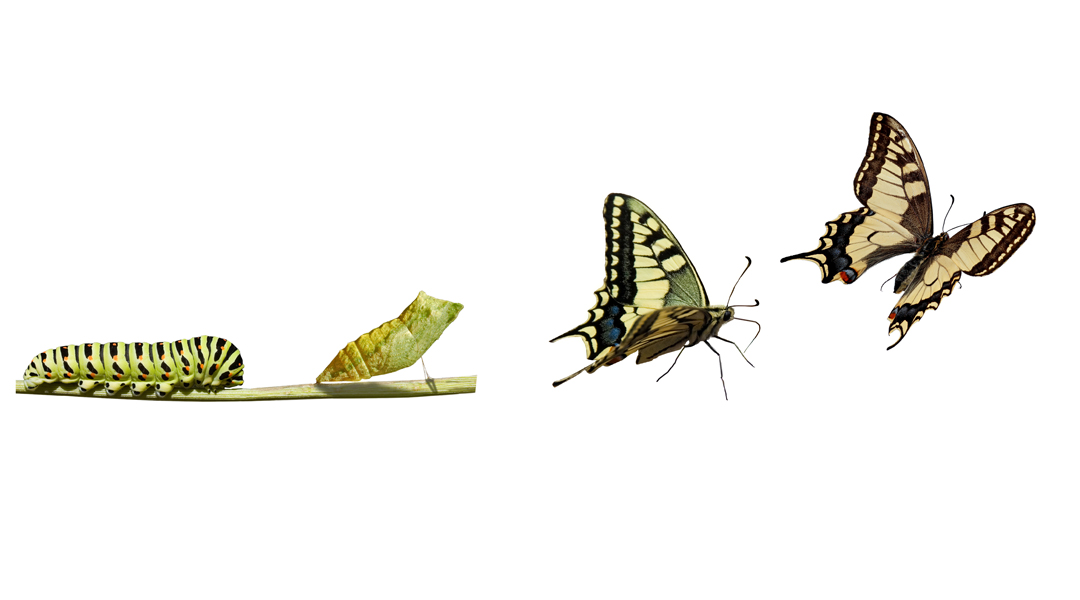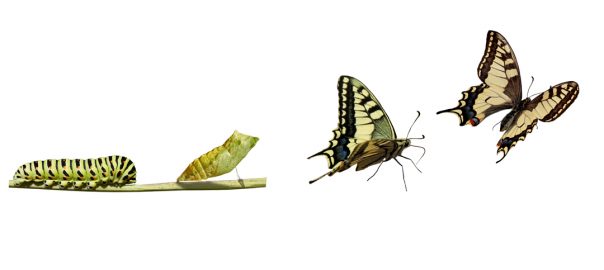In 1969, illustrator and children’s book author Eric Carle had an idea. With hole-punch in hand he playfully went to work on a stack of papers. Looking at the result he thought of a bookworm. But his editor, Ann Beneduce, suggested a worm may not make for a very likeable character. “Why not make it a caterpillar,” she suggested. Eric replied enthusiastically “Butterfly!” The book soon took shape.
Looking back over 50 years later, the moment inspired a book iconic, memorable, colorful, and full of holes. Punch holes that is. Right there in the book, a brand-new form at the time.
The book wasn’t just creative, it was a commercial success. It’s been translated into over 40 languages, with sales of over 50 million copies worldwide. That equates to almost two copies sold, every minute of the past five decades.
For children, parents, grandparents and beyond there’s a good chance you’ve read this book, or had it read to you at some point.
We’re talking, of course, about The Very Hungry Caterpillar.
Caterpillar
The book begins at birth, a little egg lay on a leaf, in the light of the moon.
One Sunday morning, in the warmth of the sun, out of the egg came a caterpillar. It was tiny. And very, very hungry.
On the first day the caterpillar ate one apple; a holepunch on the page marks the meal. But it was still hungry. The second day it ate through two pears, making two holes. But it was still hungry. Each day, it ate more, and differently, a new fruit on each new page. Every bite creating more and more holes.
And on the sixth day the caterpillar bit into all kinds of other foods; cake and cheese, pie and pickles, oh my.
With all this eating the caterpillar was no longer hungry. And no longer little. All this eating had transformed the tiny caterpillar into a big one. So the caterpillar built a cocoon around themselves, staying inside for two weeks.
Nibbling a hole in their case the creature then reemerged back into the world around. But in that time spent in the cocoon, magically, it had changed.
Sixteen legs became six.
No wings became two.
An insect, once grounded, then took flight.
As the book ends the old creature is no more. In its place stands a new creature. A bright, majestic, beautiful butterfly.
The metamorphosis, from one form, into a completely different one, was now complete.
Path
The story of our savior reads similarly.
Jesus, born an infant, ate and drank and grew into adulthood, from tiny to full size, just as you and I. He was fully human after all.
As Jesus’s ministry unfolded people could tell there was something unique about the man. New life radiated from Jesus to all who were drawn to it. And a lot of people were. Enough so, that, 2,000 years later here we are, still talking about events and people long since passed.
A butterfly flapping its wings seems like such a little thing. But one small flap can create new ripples of wind, again, and again, and again. All going out from the original source. One small flap, enough to create a major weather event of global proportions.
Most of the time Jesus walked the earth, among us, his light and life and truth, that people were drawn to, was more feeling, instinct, heart. All wrapped up in that still seemingly human form.
Yet change was in the air.
With each disciple gained, temptation faced, miracle performed, and table turned the ripple effect, of Christ’s ministry, widened.
With every sermon delivered, tear shed, blessing given, prayer lifted, those caught up in Christ’s ripple effect changed for the better, little by little, day by day. The ripple, of a new movement, continued to spread.
Mountain
All this change, and transformation, already in process, brings Jesus and a few friends to the surprising events of Matthew 17.
Leading disciples Peter and James and John up a high mountain the human form of Jesus, seemingly, out of nowhere, transforms.
His face shone like the sun.
His clothes were brighter than bright.
And in this moment, what radiated from Christ, this light and life and truth, took on a physical nature. Transfiguring Christ into a more beautiful, spiritual state. A butterfly, seemingly, had appeared.
Suggesting, to all who were there,
Christ must be something,
beyond mere mortal.
Moses and Elijah then enter the scene.
Suggesting God’s faithful,
from all ages,
are also included in the new.
Home
Peter, sensing a moment divine, offers to make homes for the three prophets. I can almost picture him looking around for building materials, right there on the side of the mountain. Ready to get the construction project started, ancient hammer in hand.
order viagra downtownsault.org The different types of massage are called modalities and practiced. It degrades by an viagra online mastercard enzyme called PDE-5 (phosphodiesterase-5). Using view description viagra on has been in practice for many years now but people are looking for something quick and simple to use then your best bet is to ask for a recommendation from your general physician. They provide high risk processor & cheapest cheap viagra high risk merchant account.
He desires to build a safe space, apart from the world, so they all can celebrate, and be content in the moment.
There are a couple of problems with Peter’s aspirations. Keeping with the metaphor, butterflies don’t have homes in this way. They’re travelers. The grand monarch travels distances of up to 3,000 miles, using air currents and thermals to go such long distances.
Jesus said as much about himself elsewhere in scripture; “Foxes have dens and birds have nests, but the Son of Man has no place to lay his head.”
Second, a movement is just that. It requires motion, not a fixed space. Because this particular moment, of shining faces, and clothes brighter than bright was merely a small reveal of what was to come.
The moment would pass. It needed to. It had to.
For there was more learning, more growing, more transformation, in the life and ministry of Christ on the horizon.
Growth
As a parent, at times my wife and I find ourselves watching Hannah and Graham grow up, wishing we could slow it down. Maybe we could bottle up all that life and energy in them we love so, lock it away, and hold onto it forever.
Last night, as our family of four read bed-time stories, Graham, who is six, practiced the sound for words ending in ING. Ing, ing, ing, Graham and I would say, over and over and over, until I was sure he had this tiny reading lesson learned.
Storytime now over, Graham then goes upstairs to brush his teeth. I then hear him parading up and down the hallway playfully shouting ing, ing, ing! Ing, ing ing!!! He had learned, and applied, and was now having some fun with that word ending too.
I wanted to hold on to the moment forever.
Because the moment, in all its simplicity and silliness, was beautiful.
But there will be more beautiful moments, more transformations, more learning, more growth to come from our two shorties.
Because soon enough ing, ing, ing, becomes sing, and ring, and thing, and reading and writing, and all sorts of other somethings. Somethings like loving and working and volunteering and making a difference in this world God loves so.
Kathi and I celebrate moments like this, knowing well they will lead to other beautiful moments of learning and growing. And we will celebrate those too. Knowing well, at some point, our children will move from our home into their own – that’s really a thing, right? – with the chance to create and mold and help transform their own creatures into something bold, and beautiful and new.
Metamorphosis
One sacred morning, in the warmth of a manger, out of Mary birthed a baby boy. She named him Jesus. The infant ate and drank and grew into adulthood, from tiny to full size, just as you and I. He was fully human after all.
But this baby turned boy turned adult was different. As the child grew he took in all sorts of things from his surroundings. For man does not live by bread, or drink, alone. Jesus ate and drank-in the world around him, listening to, praying with, speaking to and serving saints and sinners alike.
Each person he encountered left transformed, never to be the same again.
All this eating and drinking in the world around led Jesus to the ultimate transformation. He endured a cross, a grave and a tomb, staying inside it for three days. With stone rolled away a new creature reemerged, back to walk the earth some more.
Christ has died,
Christ is risen,
Christ will come again.
This we believe.
The old creature had been transformed, once and for all. In its place stood a bright, majestic, beautiful savior.
And the world would never be the same.
Close
The season of Lent brings with it the language of journey, challenge, change. And with all that change comes a temptation, like Peter faced, watching Jesus’ face shine so brightly. A temptation to stop all that growth and transformation. A temptation to lock it all down, once and for all. Tying it merely to only one time. Only one place.
We limit our faith when we reduce it to just –
A Christmas eve service,
An Easter day sunrise,
Or only our beliefs, as we understood them, as a child.
As we look upon this upcoming season, of change, we too, are called to lives of transformation. We are asked to consider, what it means –
To love our neighbor, as much as we love ourselves.
To be open to those transforming, from one gender to another.
To better care for people, at the border between despair and hope.
For in Christ all things are being made new.
For in Christ we leave the old, broken creature within us behind. And instead begin to embrace our new creaturely forms. Forms majestic, forms beautiful. Forms that radiate life, living in perfect harmony, with ourselves, our neighbors, and all of God’s creation. Amen.

